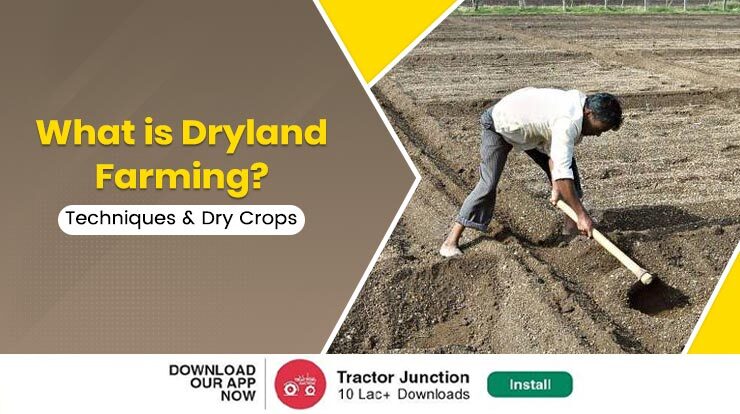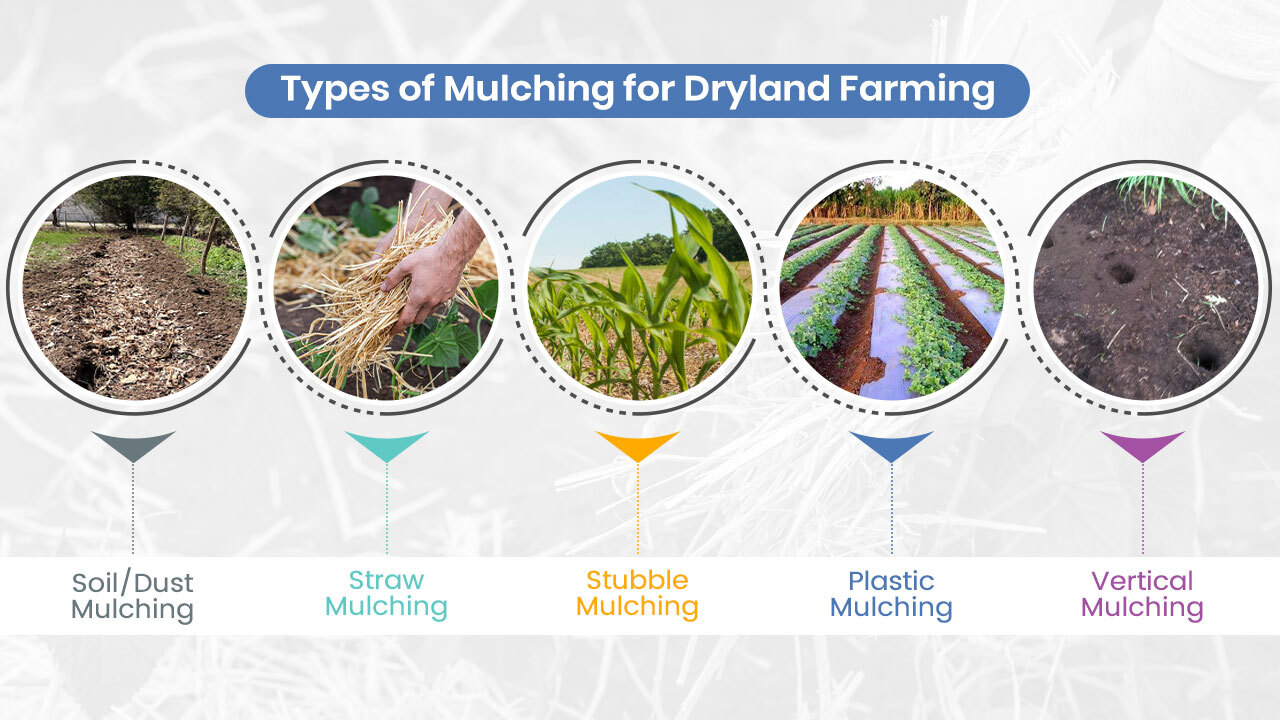
A large part of India is characterised as arid that means the scope of conventional rainfed irrigation is less in such areas. Thus, Dryland farming in India was adopted to leverage these areas despite their scarcity in rainfall and irrigation facilities.
Dryland farming or dry farming is a method where arid and semi arid regions are opted and cultivated with drought-resistant crop varieties. In addition, with some methods to prevent their water evaporation and transpiration of plants.
Let’s walk though the complete guide to:
- What is Dryland farming?
- Importance of Dryland Farming in India
- Dry Farming Techniques
- Major Dryland Farming Crops
- Indian states where Dryland farming is practised
What is Dryland Farming?

Dryland farming refers to crop production in an area with less than 500 mm of annual precipitation. Furthermore, the method involves the growing of crops from the moisture stored in the soil from the previous rainy season.
Dryland areas often are characterised by areas with irregular or deficit rainfall or areas without assured irrigation systems. Such areas are known to receive rainfall between 500 and 1200 mm. To prepare the land for dry farming, tractors like John Deere 5050 D and New Holland 4710 paddy special are highly preferred by farmers.
The Importance of Dryland Farming in India
Dryland farming is highly advantageous as it helps grow crops in arid and semi-arid regions without depending on natural rainfalls. With constant climate change, certain parts of India face a chronic supplemental rainfall shortage. Thus, this dry land farming appears as a sustainable solution to grow crops despite shortages.
3 Principles of Successful Dryland Farming
Dryland farming in India depends on 3 principles:
- Precipitation of the land must be retained.
- Opting of methods that can retain soil moisture to avoid evaporation or transpiration.
- Using drought-resistant crops that aren’t reliant on heavy and frequent rainfall.
Dryland Farming Techniques – What You Must Know?
The primary objective of this farming method is to lock water in the soil for later use during dry growing seasons. Here are the following practices that are done to pursue dryland farming:
- Methods involve the use of drought-resistant crops that can survive in dry weather conditions. Also, the crops used in this farming type can be early maturing, dwarf or mini cultivars.
- The rainfall must be about 10 inches per year (almost 250mm).
- Farmers must prevent heat & evaporation during the planting and growth stage.
- The soil must be preserved in a way it absorbs the maximum moisture from the previous rainy season. It should be deep, about 10 feet to 3 metres. It shouldn’t contain any sand, clay, or gravels that can restrict water flow. The feasible soil depth at minimum is 18 inches (450mm).
However, note that the water storage capability and drought resistance of any soil increases with more soil depth.
Methods to Increase Water Absorption in Soil for Dryland Farming
Avoid Crusting at Soil Surface
Soils tend to seal or crust against water intake, thus, it is important to prevent them. The rainfall can break down the clods and disperse the soil.
- Tillage could be done to create a cloddy surface. Also, this process helps increase the timeline required to break the clods by raindrops and seal the surface. Small seeds should have fine bed than large seeds.
- Post harvest, add a layer of mulch. Also, this will help slow down flow of rain water and help with increased water absorption.
Read: Top 10 Puddling Special Tractors 2022
Reducing Runoff Water
To a limit, waterclogging isn’t an issue. However, the running water shouldn’t be excess as it can lead to erosion. Following practices can be adopted to absorb water.
- Cropland should be levelled well.
- All tillage & planting should be done perpendicular or across the slope of land. Also, this would impede the flow of downward water movement.
- Building bunds or contours can help retain water.
Also Read: What is Contour Farming? How to Perform?
Methods to Reduce Loss of Soil Moisture/ Evaporation
Soil moisture is very important to ensure crops sustain in the dry growing seasons. The following methods can be adopted to trap soil moisture from previous rainfall.
- Using Mulches
- Wind Breaks Uses
- Using Antitranspirants
- Controlling Weed
1. Using Mulches
Soil’s 60-75% of rainfall can be lost through evaporation. Layering soil with mulches helps with avoiding soil moisture. Other than that, it helps with conserving soil, maintaining temperature, reducing soil sanity, controlling weeds and maintaining soil structure.

Types of Mulches to Use
Following types of mulches can be used to protect soil from water evaporation.
-
Soil/Dust Mulch
Loosened soil or dust acts as a soil mulch that protects the evaporation of water from the soil. Also, this loose soil is called dust or soil mulch. Moreover, inter-cultivation helps create dry mulch for growing crops.
-
Straw Mulch
Straw or crop residue can be used as a mulch to protect the soil from evaporation. Thus, this is called stubble mulch.
-
Stubble Mulch
Use of wheat straw or cotton stalks, etc., for mulch is called stubble mulch. Also, this type of mulch helps protect against soil degradation and water evaporation.
-
Plastic Mulch
Some farmers prefer to use polyethene or polyvinyl chloride to cover the soil and protect it from evaporation.
-
Vertical Mulching
To improve rainwater retention and infiltration in soil, narrow trenches are created across the field, which is called vertical mulching. Moreover, these narrow trenches are covered with crop residues or straws.
2. Wind Breaks & Shelterbelts Uses

Creating windbreaks and shelterbelts helps protect the field from heavy winds. Moreover, these belts or breaks are created with large plantings and vegetation. Moreover, the purpose of these large plantings is to reduce wind erosion, protect growing crops or plants, and prevent their evaporation.
3. Using Antitranspirants
Almost 99% of the water absorbed by plants is lost due to transpiration. If transpiration is managed, it can help to ideal water balance.
Antitranspirants, when applied to plant surfaces, can help reduce water loss. Antitranspirants lessen the photosynthesis process. Furthermore, their use is to prevent the crop from major moisture loss. Also, they are highly used in nurseries and horticulture crops.
4. Controlling Weed
Weeds lead to major transpiration compared to crops. Moreover, weeds can take all the soil moisture required by crops. Thus, it’s important to control and prevent weeds during dryland agriculture.
Major Dryland Farming Crops
Following are the dryland farming crops in India that are suitable for growing in areas with a shortage in rainfall.
- Wheat
- Corn
- Millet
- Rye
- Pumpkin
- Beans
- Tomatoes
- Grapes
- Beans
- Maize
- Sunflower
- Watermelon
Major dry crops include millets such as Bajra, Jwar, ragi, mustard, oilseeds like rapeseed, pulse, crops like gram, lentil, pigeon pea, etc. Moreover, almost 80% of Jwar and Bajra, 90% of Bajra, 75% of oilseeds, and 95% of pulses are obtained from dryland agriculture in India.
The Top Indian States Famous for Dryland Farming
Do you know almost 128 districts in India have been identified as dry farming areas? Of all these 128 districts, almost 91 districts are located in Chattisgarh, Uttar Pradesh, Tamil Nadu, and Madhya Pradesh.
And rest of the districts are located in the Saurashtra region of Gujarat, Central Rajasthan, and the Western Ghats rain shadow region. Moreover, tractors like Sonalika RX 42 Mahabali and Mahindra Yuvo 575 DI 4WD are used highly for cultivating arid regions.
Conclusion
Dryland agriculture is necessary for areas where rainfall is aberrant, and drought-resistant crops can be cultivated. Since a large part of India has growing seasons with dry spells of more than 200 days, it becomes necessary to adopt unconventional farming practices.
Thus, dry farming is majorly practised in districts of Chattisgarh, Uttar Pradesh, Tamil Nadu, and Madhya Pradesh. And methods like mulching, tillage, use of antitranspirants, developing contours and bunds can help lock moisture from previous rainfall.
To get updated on latest farming and agricultural practices, stay tuned to Tractor Junction’s blog.
Frequently Asked Questions
Que. What is the difference between dryland and rainfed farming?
Ans. Dry land farming is cultivation in areas where rainfall is less than 750mm and rainfed farming is where rainfall received is more than 750mm.
Que. Which type of cropping is adopted in dryland farming?
Ans. Crops for dryland farming include corn, wheat, corn, rye, millet, and other grasses that produce grains.
Que. What do you mean by dryland farming?
Ans. Dryland farming is cultivating crops in an area with less than 500 mm of annual rainfall.
Que. What is the difference between dryland and wetland farming?
Ans. Dryland farming is the cultivation of land with rainfall of less than 500 mm annually. Whereas wetland farming is done in the presence of a waterbody or near a water land.
Que. Which crop is not cultivated under dryland farming?
Ans. Sugarcane is a water intensive crop and cannot be cultivated for arid reasons. Thus, sugarcane crop is not cultivated under dryland farming.
Que. Which is the most suitable crop for dry land farming?
Ans. Ragi is a suitable crop for dry land farming since it requires rainfall of less than 700-1200 mm annually.
Related Post
Pearl Farming in India – Process, Investment Cost & Margins
What is Urban Farming in India?



